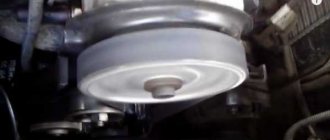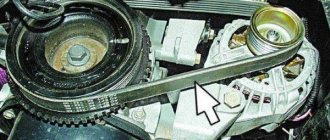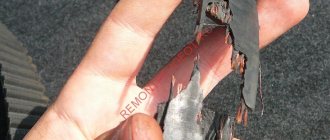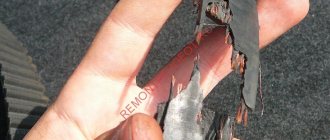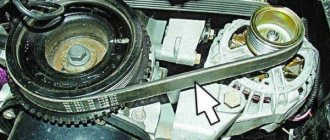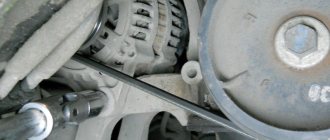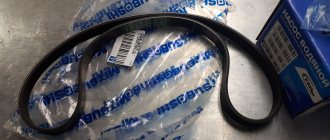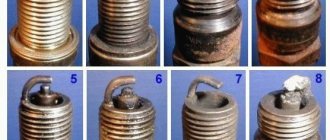How to determine that a car's timing belt has jumped
Like any other car component or part, the timing belt performs certain functions.
It is entrusted with a significant option, and due to the convincingness of its functioning, the operational duration and security of the automotive power plant as a whole is determined. Jumping or slipping of the timing belt is a fairly common phenomenon familiar to many motorists.
The belt slips one tooth or several. We are talking about the teeth of the crankshaft or camshaft flywheel. It is clear that such a situation can lead to serious problems.
Signs and symptoms
There are six main signs that the timing belt has jumped.
- The car engine is unstable.
- The engine constantly stalls.
- Noticeable loss of engine power and thrust.
- The engine starts with problems or does not start at all.
- The power plant is stuck.
- The sound of the engine becomes louder - a metallic knock appears.
Most often, it happens that the product jumps one tooth, and because of this, the engine continues to operate, but increases fuel consumption, and there are also interruptions in operation and starting.
If you suspect that several teeth have jumped, you should not restart the engine. In the worst case, this can cause the valves to bend.
Also, to avoid timing belt breakage, you should pay attention
- On the emergency lamp indicating the degree of oil pressure
- On the condition of the seals - If they become unusable and leak oil to the timing belt, it will quickly fail. The main evidence of leaks is oil stains on the asphalt or the surface of the engine.
- Avoid, as such jerks can cause a break after 20 thousand km.
Even if you follow all the tips, you cannot be sure that it will not break on the road, therefore, it will be useful to have a set of tools and a new belt for quick replacement.
New law on winter tires 2021 - 2017
Car care in winter
Consequences
The consequences of the timing belt jumping several teeth can be different - from replacing the timing belt itself to repairing the car’s gas distribution mechanism.
The amount of damage depends on whether the engine has recesses for valves in the pistons or not.
A jump can occur while the valves are being lowered to inject fuel or release gases. The pistons are still moving and can hit the valves hard. This will lead to bending of the latter. This situation is similar to a broken timing belt. You can read more about which engines this happens on in this article.
To avoid this situation, it is recommended to do a timely inspection and, if necessary, change the consumable.
Chain
For a long time it was believed that a chain was much more reliable than a belt drive. And this is true, but the chain is far from immortal. Timing chain malfunctions also occur. If the belt breaks, then there is, albeit a small, chance to save the engine. In the case of an open circuit, the situation can be much worse. The chain is more massive than the belt, and if it breaks, it literally grinds the engine. Severe damage to valves and pistons occurs. In general, there is only one fault with the chain - it breaks.
Among the reasons include the quality of the oil. The chain's lifespan is 250 thousand kilometers, but they rarely run for that long. There are widely known cases when the chain in the engine broke after a mileage of 100, as well as 60 thousand kilometers. But this is more often a factory defect in specific cars. Often problems are associated not only with oil, but also with engineers’ mistakes.
Consequences of malfunctions
Problems in the timing chain drive lead to the following problems:
- A stretched and weakened chain jumps several teeth. As a rule, this happens when the engine starts.
- A chain operating with increased free play often breaks the guide and even “gnaws” a groove in the cylinder head made of aluminum alloy.
- In some brands of cars where a single-row chain is used in power units, it may break.
Note. Chain drives of the timing unit can be single- or double-row. The former are not as reliable and durable as the latter, and often break down after a run of 50-80 thousand km. Double-row drives break extremely rarely, even when the owner of the car does not pay due attention to it.
Double-row chains also break, but very rarely
The consequences of these problems may be as follows:
- The most harmless option is a shift in valve timing due to the chain jumping 1-2 teeth. The engine does not start well and vibrates strongly during operation, and there is a clear loss of power while driving. When you press the accelerator pedal sharply, shots are heard in the intake manifold or exhaust pipe.
- When there is a 3 tooth offset, the engine will no longer start. Another thing is that in practice such situations are rare; a too loose chain skips much more. The result is a piston hitting a valve that opened at the wrong time.
- Due to severe wear or breakage of the damper, the chain drive is weakened even more, causing the consequences described above.
- The damage caused by a broken single-row chain depends on the type of engine and the moment when it happened. If all the valves were closed, then the pistons, which continued to move, would not reach their plates.
This is what the valves look like after meeting the pistons
In power units with 8 valves, encounters with the piston are quite rare due to the technological clearances provided for by the design (except for individual motors). But a 16V engine valve that is open when the chain breaks or jumps almost always receives a blow from the piston. As a result, its stem bends and the valve remains in the open position. In especially severe cases, the consequences are as follows:
- even the valve seat and guide bushing are damaged;
- a through hole appears in the upper part of the piston;
- A dent appears on the plane of the cylinder head near the combustion chamber, which makes it necessary to replace it entirely.
A chain that has jumped or broken while driving makes itself felt by a sharp loss of power or complete engine failure. If you were able to hear a metallic knock, indicating the meeting of the piston and valve, then you should prepare for serious repairs to the power unit.
And this is a piston pierced by a valve plate
Repair cost
The average price for replacing a belt and roller in car services ranges from one to three thousand rubles. The price range is due to the fact that replacing parts on foreign cars costs approximately 2–3 times more than on domestic cars.
If it turns out that you also need to change the engine water cooling pump and the crankshaft oil seal, then the price will increase by another 1 - 1.5 thousand rubles.
Although there is a huge selection of products on the market at different price levels, you should only choose brands recommended by the manufacturer or their high-quality analogues. Using cheap parts can lead to serious damage and expensive repairs.
For example, if the valves are bent as a result of a belt slipping, then almost the entire cylinder head will have to be replaced. Even if the repair is carried out by yourself, the cost of replacing valves, pump, belt, filling oil and antifreeze, and other parts will be at least 10,000 rubles.
The timing belt on a car engine ensures synchronization of the crankshaft with the timing shaft (camshaft).
On engines with a timing belt, breaking it or slipping even one tooth can lead to serious problems, which in the future may lead to a major overhaul of the engine.
Symptoms of malfunction
The main signs that the belt or chain has slipped:
- change in throttle response, power, engine torque;
- increase in the toxicity of exhaust gases, their shade;
- problems when starting the engine;
- a “check engine” error message appears on the dashboard;
- the occurrence of extraneous noise of a non-metallic (for belt drive) and mechanical nature (for both chain and belt drives).
If such signs appear, you should stop driving (start the engine), have the engine diagnosed, or contact a mechanic.
This is how a timing belt works
The timing belt is an important element of the car, so it needs to be serviced promptly. The reasons that lead to its jump are the following:
- Contact of oil or cooling liquid on the belt surface
- Improper use
- Late replacement
- External damage
- Incorrectly placed labels
- Difficult operating conditions
- Low quality spare parts
Of course, these are not all cases due to which the timing belt breaks or jumps. But this can be understood by the following signs.
Gentlemen, has anyone had cases where the belt was not on the marks by 1-2-3 teeth? What are the symptoms and how does it manifest itself in operation? Troits, knocks, rings? Otherwise, there are suspicions after the replacement.
on 3S something like that. With just one tooth, the car started with half a kick, but when you pressed the gas pedal there was a ringing sound in your fingers. My father-in-law's Crown 1G refused to start at all)))
When pressing the gas at idle or while driving? I just get a ringing sound when I move and lightly press the gas.
What's stopping you from removing the covers and checking the marks? If everything is fine, then the electrician needs to set the ignition with a strobe light (in this case, a jumper is placed in the diagnostic connector between Te1 and e1)
both in place and on the move
I really appreciate your participation and admit that I did not provide complete information about the car. You see, I have a 7A-LB engine and the ignition on it is not adjustable. In addition, having worked as a diagnostician myself (albeit for Volvos), I would not have asked a respected forum for help if everything was so simple.)
Wow, this is not my case, I only have it while moving and only with a fully warmed up engine.
I'm waiting for more comments)
By the way, the same canoe after replacing the timing belt, according to the marks, everything is correct, I removed the cover twice, but the ignition stops earlier, I feel it, detonation appears too often. When the heat is not scary, but when frosts start, there may be problems with starting. Even if you fill the gasoline with 98, it still makes a jingling sound. And the tooth here and there won’t be anything terrible, just not big problems. On the jig, I specially threw the chain over one tooth when I went long distance, it ran more fun.
It’s very wrong for you to think so about a mistake of one tooth. Yes, it will start without problems even by 2-3 teeth, but it won’t drive normally even with a mistake of one tooth or it will start guzzling fuel like crazy. Zhiguli is not an example, you know why. And what are the problems, check the installation of the timing belt, there are a lot of books there, everything is simply described there, or ask someone who knows.
By the way, as an option, detonation occurs from severe coking of the CPG, then detonation is practically invincible without drastic measures.
Changes in engine performance after jumping
Typically, timing belt or chain jumping occurs as a result of the simultaneous action of several factors, for example, stretching, increased load during engine starting or driving. In this case, skipping can occur through the gears (pulleys) of both the crankshaft and the camshaft pulley. After this, the ignition shifts towards late.
The amount of this displacement in angular units depends on the number of timing belt teeth or chain links. A shift of the timing belt by one tooth corresponds to a change in the ignition angle by an amount equal to the ratio of 360 angular degrees/number of teeth. For example, if the number of teeth is 100, then the offset will be about 3.6 degrees.
A delay in the engine ignition angle by this amount often does not exceed the operating parameters of the engine.
When displaced by one tooth (link), the engine usually works. The following changes are observed:
- increased fuel consumption;
- difficulty starting the engine;
- increased toxicity of exhaust gases;
- reduction in engine response.
In the case when the belt has slipped by more than a tooth, the change in the ignition angle is more than 5 angular degrees. This is a critical value. In modern cars, the control unit usually turns off the engine to prevent serious mechanical damage, especially in engines where the pistons “meet” the valves in such a situation. Experienced drivers, when choosing or purchasing a car, are specifically interested in whether pistons and valves are found in a given model of engine installed in the car.
When a belt (chain) jumps over two or more teeth (links), the following are observed:
- misfires;
- uneven engine operation, the engine naturally “sausages”;
- engine start failure;
- extraneous sounds when the power unit is operating.
Operating a car in such a situation is extremely dangerous.
P0340 or the timing belt does not hit 1 tooth - logbook Hyundai Getz 1.6 16V 2004 on DRIVE2
The receipt from the purchase was on fire. The owner threw up his hands, saying he blinked when it caught fire, but the car was running, so there was no need to get into it. I immediately thought it was error 340 - an error in the camshaft sensor circuit. The Internet said that it was the Khan sensor, that oil could get into its contact and that’s all, provided that the car was driving. I accidentally came across on some website about other cars in general that the same error was on, but as it turned out, the timing belt did not hit 1 tooth according to the marks. The car is moving, but the gas timing is already off. In contact with the Goetz group, the guru immediately said that if the timing belt is knocked off by 1 tooth, then the valves will knock. In the group of accent guides (their motor), essentially no one answered anything. And the other day, one comrade in the accent group made a note that error 342 was on, he opened the covers, and there on the camshaft pulley the mark did not match by 1 tooth, he set everything again, the error went out and the car froze. Well, I read a lot of manuals (most smart), bought a 22 head and went to the garage with jitters and trembling in my knees) I’ll say right away that there’s nothing complicated, just very scary.
Broken timing belt: causes and consequences
Purpose of the timing belt
The timing belt is an important element responsible for the synchronous and harmonious operation of the camshaft and crankshaft of an internal combustion engine. The part is responsible for the function of timely opening and closing of valves. A fully functional belt turns the camshaft at a strictly specified pace - exactly two times slower than the crankshaft turns. During the rotation of the camshaft, a fuel-air mixture (FA) is supplied to the engine cylinders, and exhaust gases are discharged through the exhaust system. A broken timing belt disrupts the entire normal operating cycle of the power unit, and can lead to serious consequences.
Belt drive was introduced by manufacturers to produce lighter and cheaper automobile engines. At the same time, the noise of the running motor has been significantly reduced. But ordinary consumers paid for everything. Innovations in terms of installing the timing belt have brought problems with maintenance and replacement. The service life of a belt drive is much shorter, and during its operation one should constantly “monitor” its condition and tension.
The designers implied that the timing belt itself must simultaneously have high strength, which is close to the chain, and be completely elastic and wear-resistant. As a result of design efforts, a three-layer timing belt design appeared.
Timing belt replacement interval
Even if the engine’s performance is satisfactory, do not forget to timely check the condition of the timing belt, because it also has a wear limit. You can find out this value from the car’s technical passport, but you can do it much simpler: it is recommended to change the spare part every 50 thousand kilometers. If you bought a used car and don't know when it was last replaced, visually inspect the belt. The appearance of microcracks on the body is the first sign of concern.
However, do not panic, because microcracks do not mean that the assembly will break at the first load. Inside it has a metal base made of thin rods. This allows you to withstand impressive shock loads and not tear for a long period of time. On some models, automakers install impact-resistant belts with reinforced metal cord. Thus, it is possible to extend the service life by approximately 30%.
Causes of timing belt breakage
There are several reasons why the timing belt breaks, and to determine them you need to have at least a little understanding of the structure of the power unit. Often, drivers encounter this problem after replacing a belt or repairing the gas distribution mechanism, which is associated with replacing valve guides.
Causes of timing belt breakage
The timing belt is one of the main elements of a car that needs to be serviced promptly and efficiently. In this case, the reasons for a broken timing belt may be the following:
Untimely replacement of the unit. As a rule, the manufacturer recommends replacing the product after 60-70 thousand kilometers. But recommendations may differ - each manufacturer can indicate its own time parameters, which are often more or less than the period we mentioned.
Incorrect operation. The belt can break not only due to natural aging, but due to errors in the operation of the entire unit. For example, if the tensioners, rollers or pump jam while driving, the resulting impulse can lead to a rupture of the timing belt. It looks strong and doesn't tear. When the rotation of the crankshaft reaches 5-6 thousand revolutions, any sudden impulse can lead to irreparable consequences. Particular attention should be paid to belt tension. Often the cause of rupture is its constriction. On the other hand, weakening the tension can lead to a problem with similar consequences - the belt jumping off the pulley grooves. There is a high probability of the same situation if there is strong play in one of the pulleys. That is why it is so important to promptly check the timing belt tension and the condition of all system elements.
Oil getting on the surface. When the first traces of oil or coolant appear on the timing belt, the product must be replaced. Otherwise, the entire gas distribution mechanism may not operate efficiently, the belt may slip, jump off the pulley, or even break. Many car enthusiasts make a big mistake - they simply wipe off the existing dirt with a rag and continue to use the car.
As practice shows, once technical liquid gets on the belt texture, it is no longer possible to remove it. Rubber literally absorbs oil and loses its quality. You can only save yourself by replacing it.
Low quality product. When purchasing a timing belt on the market “cheaply,” be prepared for “surprises” during operation. Please note that saving in this matter will inevitably lead to even greater costs in the future. If you are going to buy parts for a car, they must be original. In this case, you will be absolutely sure of their quality and declared service life. Service station technicians are well aware of situations where, because of a few hundred rubles in savings, car owners spent tens of thousands on repairs. This is not surprising, because a low-quality timing belt may not last even 20 thousand kilometers. Believe me, driving and expecting the belt to hold up at any time is not the best pleasure.
External damage. Due to natural wear and tear or poor quality, various defects may appear on the belt, for example, indentations, cracks, peeling of threads at the end of the product, and so on. Such defects cannot and cannot be eliminated. The only solution in this case is to install a new belt. You shouldn’t ignore the problem either, because at maximum load even a small defect will develop very quickly and cause the belt to break. Subsequently, you can blame yourself for a long time for being slow, but you can’t return the past.
A little theory
Chain drives transmit rotational force from the crankshaft to the camshaft, which is located in the cylinder head of overhead valve engines.
Chains are divided into 2 categories. They can be toothed or roller. Roller mechanisms, unlike gear ones, are not so widespread. Therefore, it is gear systems that are most often found on cars with a timing belt, which include a chain drive.
Gear units are distinguished by their high smoothness, they are quite reliable, and produce an insignificant level of noise during the operation of the internal combustion engine. In terms of their characteristics, the use of toothed chains brings them much closer to belt drives. One can argue endlessly about which one is better.
But we won’t dwell on this today.
The chain is tensioned due to the operation of hydraulic tensioners, for which motor oil is used as a working fluid. The lubricant is supplied through the engine lubrication system.
Depending on the number of camshafts, that is, camshafts, the number of tensioners also differs. On cars there are from 1 to 3 units.
The service life of the chain directly depends on what the element is made of, how high quality it is and the degree of effectiveness of the heat treatment performed. Similar requirements are placed on timing sprockets, since they constantly operate together with the chain.
More about Nissan: NISSAN PATROL Y61 since 1997 diesel Repair and operation manual » Auto literature. Car repair and maintenance manuals
Do not forget about the influence on the condition of the unit of the engine lubrication system, the quality of the oil itself and timely replacement of the fluid.
In practice, when the part is made of high-quality materials, and the correct tension was carried out as part of the service, plus lubricant was introduced on time, then replacing the chain may be necessary at the same time as replacing the motor itself.
That is, you understand that a stretched chain cannot function for a long time and effectively. If you want to extend the life of this unit, initially take a high-quality chain, adjust its tension correctly and lubricate the drive generously with high-quality oil.
Broken timing belt: causes and consequences
Purpose of the timing belt
The timing belt is an important element responsible for the synchronous and harmonious operation of the camshaft and crankshaft of an internal combustion engine. The part is responsible for the function of timely opening and closing of valves. A fully functional belt turns the camshaft at a strictly specified pace - exactly two times slower than the crankshaft turns. During the rotation of the camshaft, a fuel-air mixture (FA) is supplied to the engine cylinders, and exhaust gases are discharged through the exhaust system. A broken timing belt disrupts the entire normal operating cycle of the power unit, and can lead to serious consequences.
Belt drive was introduced by manufacturers to produce lighter and cheaper automobile engines. At the same time, the noise of the running motor has been significantly reduced. But ordinary consumers paid for everything. Innovations in terms of installing the timing belt have brought problems with maintenance and replacement. The service life of a belt drive is much shorter, and during its operation one should constantly “monitor” its condition and tension.
The designers implied that the timing belt itself must simultaneously have high strength, which is close to the chain, and be completely elastic and wear-resistant. As a result of design efforts, a three-layer timing belt design appeared.
Timing belt replacement interval
Even if the engine’s performance is satisfactory, do not forget to timely check the condition of the timing belt, because it also has a wear limit. You can find out this value from the car’s technical passport, but you can do it much simpler: it is recommended to change the spare part every 50 thousand kilometers. If you bought a used car and don't know when it was last replaced, visually inspect the belt. The appearance of microcracks on the body is the first sign of concern.
However, do not panic, because microcracks do not mean that the assembly will break at the first load. Inside it has a metal base made of thin rods. This allows you to withstand impressive shock loads and not tear for a long period of time. On some models, automakers install impact-resistant belts with reinforced metal cord. Thus, it is possible to extend the service life by approximately 30%.
Causes of timing belt breakage
There are several reasons why the timing belt breaks, and to determine them you need to have at least a little understanding of the structure of the power unit. Often, drivers encounter this problem after replacing a belt or repairing the gas distribution mechanism, which is associated with replacing valve guides.
Causes of timing belt breakage
The timing belt is one of the main elements of a car that needs to be serviced promptly and efficiently. In this case, the reasons for a broken timing belt may be the following:
Untimely replacement of the unit. As a rule, the manufacturer recommends replacing the product after 60-70 thousand kilometers. But recommendations may differ - each manufacturer can indicate its own time parameters, which are often more or less than the period we mentioned.
How to choose a new set of spare parts
Like other automobile spare parts, timing chains are counterfeited by handicraft and Chinese manufacturers, after which they go on sale. Cunning businessmen are constantly coming up with new ways to deceive customers, for example, placing their low-quality products in original packaging from well-known brands originally from Western Europe. To avoid running into a fake spare part when purchasing a part, follow these recommendations:
- buy the chain from official sales representatives, dealers, or in stores that have a positive reputation among other users;
- do not try to save money by looking at products from unknown manufacturers;
- check the part for marks and deflection in a horizontal position;
- consult a familiar auto mechanic about which brand is best to choose for your car brand;
- Make a visual inspection of the product for careless workmanship or other signs - burrs, play between links, and so on.
The chain is checked for deflection as follows: take it by one end and hold it flat. The second end should sag no more than 10 mm. If possible, check the hardness of the metal by carefully filing it with a file. The steel in high-quality products is hardened, and therefore is characterized by increased hardness and does not lend itself to filing.
Chain, gears, shoes and tensioner - complete replacement kit
Advice. The main technical characteristics of the chain are its size and number of links, and you need to select the part based on them. If you are in doubt, then do not buy a new spare part without removing the old one with which you can compare it.
If you are updating a chain drive with a significant mileage of the car (150-200 thousand km), then you will have to change all the accompanying elements - gears, tensioner and damper. When the chain has stretched after a run of 50-100 thousand km, it is not necessary to change the gears, but the tensioner must be checked for functionality. Also, don't forget to buy consumables - cover gaskets, O-rings and heat-resistant sealant.

